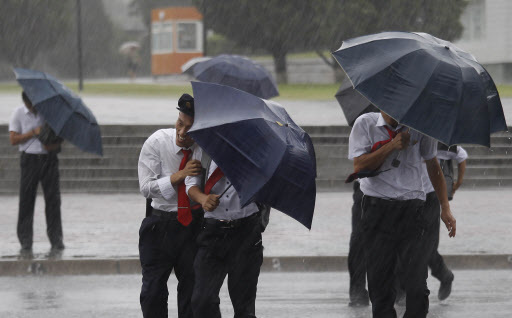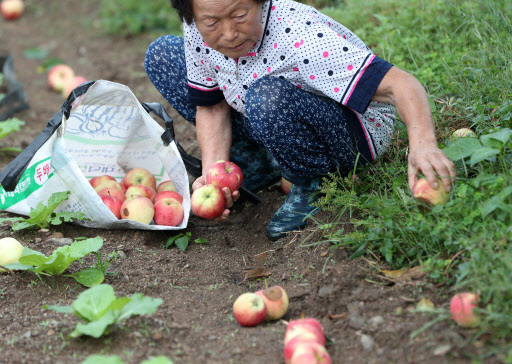Typhoon Lingling leaves 3 dead, more than 20 injured
By Ock Hyun-juPublished : Sept. 8, 2019 - 15:53
Typhoon Lingling, the fifth-strongest typhoon to hit South Korea, left three people dead and more than 20 injured, caused power outages, disrupted transport services and damaged farmland and properties, with recovery operations underway Sunday.
The typhoon, which made landfall near the southern island of Jeju on Friday night, rapidly swept along the country’s west coast Saturday with strong winds and heavy rain before heading toward North Korea in the afternoon, according to the weather agency.
The typhoon, which made landfall near the southern island of Jeju on Friday night, rapidly swept along the country’s west coast Saturday with strong winds and heavy rain before heading toward North Korea in the afternoon, according to the weather agency.

As of 11 a.m. Sunday, three people had died and 23 people were injured, according to the Ministry of the Interior and Safety.
A 75-year-old woman died after she was knocked down by strong winds in Boryeong, South Chungcheong Province. In Incheon, a 38-year-old bus driver was crushed to death by a collapsed wall at a hospital parking lot. In Paju, Gyeonggi Province, a 61-year-old man died after being struck on the head by a blown-off roof panel.
A total of 23 people -- 12 ordinary people and 11 firefighters and police officers -- have been treated for injuries from strong winds.

Farmers and fishermen were among those hardest hit.
At least 7,000 hectares of agricultural areas were affected by the typhoon.
A total of 4,253 hectares of rice plantations were damaged, and 1,735 hectares of farmland were flooded. In addition, 1,157 hectares of fruit farms saw their fruits affected.
Also, 35 ships were overturned and seven fish farms suffered damage.
Other related accidents have also been reported across the nation, according to fire authorities, with 2,444 trees and 125 lampposts uprooted, 80 buildings flooded, 84 vehicles damaged and 419 signposts blown off.
There were reports of damage on 3,642 properties -- 928 private and 2,714 public.
Some 161,646 households experienced power outages due to the typhoon, with the majority of the affected homes in Incheon. With the peninsula out of the influence of the typhoon, the power supply was fully restored as of Sunday afternoon, according to the Korea Electric Power Corp.
Some 230 flights arriving and departing from 13 airports across the country were canceled. The Yeongjong and Incheon bridges leading to Incheon Airport were closed off, and railway services between Seoul and the airport were disrupted. The bridges reopened and passenger flight services returned to normal operations on Sunday morning
The Korea Meteorological Administration said the fastest wind speed measured was 54.4 meters per second, or 195.8 kilometers per hour, at Heuksan Ilsand off Sinan, a town in South Jeolla Province, at around 6:30 a.m., making it the fifth-strongest typhoon to hit the country on record. In 2003, Typhoon Maemi brought winds measured at 60 meters per second.
All typhoon-related warnings were lowered to the level of advisories on Sunday morning.
The government held a meeting to draw up measures for recovery operations after identifying the extent of damage for the next 10 days in cooperation with municipalities and a disaster inspection team under the Safety Ministry.
Rainfall is expected across the country until Tuesday, with Seoul and the surrounding Gyeonggi Province predicted to receive 10 to 40 milliliters of rain. Jeolla Province, South Gyeongsang Province and Jeju Island are expected to see the most rain -- up to 100 milliliters.
The typhoon also hit North Korea. The North’s state media outlets, including the Rodong Sinmun, its official newspaper, reported on the damage caused by the typhoon -- casualties, power outages, disruption to its railway service, and damage to roads and bridges.
(laeticia.ock@heraldcorp.com)
At least 7,000 hectares of agricultural areas were affected by the typhoon.
A total of 4,253 hectares of rice plantations were damaged, and 1,735 hectares of farmland were flooded. In addition, 1,157 hectares of fruit farms saw their fruits affected.
Also, 35 ships were overturned and seven fish farms suffered damage.
Other related accidents have also been reported across the nation, according to fire authorities, with 2,444 trees and 125 lampposts uprooted, 80 buildings flooded, 84 vehicles damaged and 419 signposts blown off.
There were reports of damage on 3,642 properties -- 928 private and 2,714 public.
Some 161,646 households experienced power outages due to the typhoon, with the majority of the affected homes in Incheon. With the peninsula out of the influence of the typhoon, the power supply was fully restored as of Sunday afternoon, according to the Korea Electric Power Corp.
Some 230 flights arriving and departing from 13 airports across the country were canceled. The Yeongjong and Incheon bridges leading to Incheon Airport were closed off, and railway services between Seoul and the airport were disrupted. The bridges reopened and passenger flight services returned to normal operations on Sunday morning
The Korea Meteorological Administration said the fastest wind speed measured was 54.4 meters per second, or 195.8 kilometers per hour, at Heuksan Ilsand off Sinan, a town in South Jeolla Province, at around 6:30 a.m., making it the fifth-strongest typhoon to hit the country on record. In 2003, Typhoon Maemi brought winds measured at 60 meters per second.
All typhoon-related warnings were lowered to the level of advisories on Sunday morning.
The government held a meeting to draw up measures for recovery operations after identifying the extent of damage for the next 10 days in cooperation with municipalities and a disaster inspection team under the Safety Ministry.
Rainfall is expected across the country until Tuesday, with Seoul and the surrounding Gyeonggi Province predicted to receive 10 to 40 milliliters of rain. Jeolla Province, South Gyeongsang Province and Jeju Island are expected to see the most rain -- up to 100 milliliters.
The typhoon also hit North Korea. The North’s state media outlets, including the Rodong Sinmun, its official newspaper, reported on the damage caused by the typhoon -- casualties, power outages, disruption to its railway service, and damage to roads and bridges.
(laeticia.ock@heraldcorp.com)
-
Articles by Ock Hyun-ju








![[KH Explains] How should Korea adjust its trade defenses against Chinese EVs?](http://res.heraldm.com/phpwas/restmb_idxmake.php?idx=644&simg=/content/image/2024/04/15/20240415050562_0.jpg&u=20240415144419)











![[Today’s K-pop] Stray Kids to return soon: report](http://res.heraldm.com/phpwas/restmb_idxmake.php?idx=642&simg=/content/image/2024/04/16/20240416050713_0.jpg&u=)